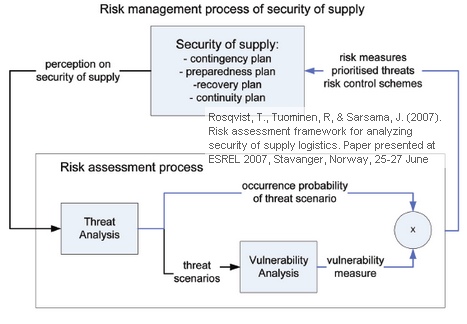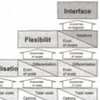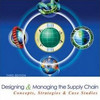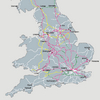 Aah…the intricacies of the English language. Not supply (chain) security, but the security of supply, as in the continuity of supply. Do you see the difference? This conference paper comes from three Finnish researchers, working with VTT Technical Research Centre of Finland and was presented at ESREL 2007, a conference that will spark many posts on this blog. Today’s paper describes how Finland views logistics and supply as important to national security and how the LOGHU project was created to develop a framework for identification and ranking of threats and corresponding countermeasures. While the paper clearly shows that the project is still a work in progress, much wisdom and food for thought can be drawn from it.
Aah…the intricacies of the English language. Not supply (chain) security, but the security of supply, as in the continuity of supply. Do you see the difference? This conference paper comes from three Finnish researchers, working with VTT Technical Research Centre of Finland and was presented at ESREL 2007, a conference that will spark many posts on this blog. Today’s paper describes how Finland views logistics and supply as important to national security and how the LOGHU project was created to develop a framework for identification and ranking of threats and corresponding countermeasures. While the paper clearly shows that the project is still a work in progress, much wisdom and food for thought can be drawn from it.
ESREL 2007
The purpose of the ESREL 2007 conference was to present a wide range of scientific papers covering both methods and applications in the fields of risk, safety and reliability. Special focus for the 2007 conference was new knowledge, theories and methodologies for the analysis and management of Risk, Reliability and Societal Safety. The papers from the conference were published in a 3-volume 3000-page monster proceedings titled Risk, Reliability and Societal Safety and it was here that I found today’s paper, along with the previously reviewed Risk in Maritime Logistics, just two of the many papers from the conference that this blog will present and review in 2010.
The concept of security of supply
What lies behind the concept of security of supply? While the term critical infrastructure may be be familiar to many of my readers, the term critical supplies is perhaps not equally familiar. It is very familiar to me. Critical supplies are goods and materials without society cannot function, e.g. food, fuels, drinking water, medicines, spare parts for critical machinery, to mention but a few. Security of supply, then, describes the activities that are undertaken and the decisions and provisions that are made to secure a nations’ functioning and the welfare of its citizens in case of major disturbances and emergency situations, and some 20 years ago that was part of my daily job when working as an adviser with the Department of Emergency Preparedness and Contingency Planning with several regional governments in Norway.
Security of supply
Initially, the concepts of security of supply were born under the cold war and were related to national preparedness, homeland security and national defense, and became perhaps slightly outdated in the early 1990s, when I started to work with it, but in today’s networked and globalized economy, where more and more goods are imported from faraway countries via supply chains that stretch around the globe, the security of supply is maybe headed for a revival. Which country does not depend on imports and would not be severely affected if supply chains were disrupted?
Critical infrastructure and critical supplies are closely knit, since the former is responsible for the distribution of the latter, while the latter in itself may be more important than the distribution channel: While securing critical infrastructure for access to remote communities is perhaps essential, one should perhaps first consider what critical supplies one needs to secure for that community. In a previous post I said that roads are more important than computers, but perhaps the computers (or other critical supplies) – in some cases – are what is more important.
A framework for risk assessment
The conference paper describes a framework for risk analysis and risk management, which I found highly viable:

Risk management is a circular and continuous process , starting with a perception of the security of supply that is analyzed for threats, and where different threat scenarios, their likelihood and the vulnerability towards these scenarios are investiagted, resulting in matching vulnerability measures. The overall threats are then fed into prioritized risk measures, which in turn form the basis for the plans for the security of supply.
Security of supply in Finland
I have been unsuccessful in googling the aforementioned LOGHU project, albeit I did find NESA, the National Emergency Supply Agency of Finland, which has a very informative website, where security of supply is defined as
the capacity to maintain the basic activities that are indispensable for safeguarding the population’s living conditions, for sustaining the functioning of critical infrastructures, and the material preconditions for maintaining national preparedness and defence in case of serious disturbances and emergency situations.
Particularly, the Finnish view of perceived threats is what I found interesting.
Consequences, not reasons, are essential. The original reasons for crises and disturbances are not essential from the point of view of security of supply. Essential are rather their consequences for economic core activities.
I think this is what should be at the heart of supply chain risk. Not the risk itself, but how you handle the risk and what it leads to.
Reference
Rosqvist, T. , Tuominen, R., Sarsama, J. (2007). Risk assessment framework for analyzing security of supply logistics. Paper presented at ESREL 2007, Stavanger, Norway, 25-27 June 2007. In: T. Aven and J.E. Vinnem (eds.) Risk, Reliability and Societal Safety. London: Taylor & Francis Group.
Author links
- T Rosqvist
(whereabouts unknown) - R Tuominen
(whereabouts unknown) - J Sarsama
(whereabouts unknown)
Links
- nesa.fi: National Emergecy Supply Agency
- vtt.fi: VTT Technical Research Center
Related
- husdal.com: Are roads more important than computers?












